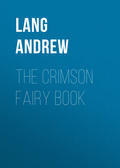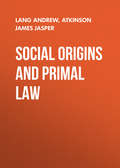
Lang Andrew
The Mystery of Mary Stuart
XVIII
LATER HISTORY OF CASKET AND LETTERS
The best official description of the famous Casket is in the Minutes of the Session of Commissioners at Westminster, on December 7, 1568. It was ‘a small gilt coffer, not fully one foot long, being garnished in many places with the Roman (Italic) letter F set under a king’s crown.’ This minute is in the hand of Cecil’s clerk, and is corrected by Cecil.[397] The Casket was obviously long in shape, not square, like a coffer decorated with Mary’s arms, as Dowager of France, with thistles and other badges, the property of M. Victor Luzarche, and described by him in ‘Un Coffret de Bijoux de Marie Stuart’ (Tours, 1868). Possibly the Casket was the petite boyte d’argent, which Mary intended to bequeath to Margaret Carwood, if she herself died in childbed in 1566.[398]
The Casket with the Letters was in Morton’s hands till shortly before his death in 1581. On November 8, 1582, Bowes, Elizabeth’s envoy in Scotland, wrote to Walsingham about the Casket. He had learned from a bastard of Morton’s, the Prior (lay) of Pluscarden, that the box was now in the possession of Gowrie, son of the Ruthven of Riccio’s murder, and himself engaged in that deed. Gowrie was at this time master of James’s person. Bowes thought that Gowrie would not easily give up the Casket to Elizabeth, who desired it.[399]
After trying to get agents to steal the Casket, Bowes sought to induce Gowrie to give it up, with promises of ‘princely thanks and gratuity.’ Gowrie was not willing to admit the fact of possession, but Bowes proved that the coffer had reached him through Sandy Jordan, a servant of the late Earl of Morton. Gowrie then said that, without the leave of James, and of the nobles, who had dragged down Mary, he could not part with the treasure, as the Letters warranted their action – undertaken before they knew that such Letters existed! However, Gowrie promised to look for the Casket, and consider of the matter. On November 24, Bowes again wrote. Mary was giving out that the Letters ‘were counterfeited by her rebels,’ and was trying to procure them, or have them destroyed. To keep them would involve danger to Gowrie. Bowes would obtain the consent of the other lords interested, ‘a matter more easy to promise than to perform;’ finally Gowrie ought to give them to Elizabeth ‘for the secrecy and benefit of the cause.’ Mary’s defenders may urge that this ‘secrecy’ is suspicious. Gowrie would think of it, but he must consult James, which, Bowes said, ‘should adventure great danger to the cause.’ On December 2, Bowes wrote about another interview with Gowrie, who said that the Duke of Lennox (Stewart d’Aubigny, the banished and now dead favourite of James) had sought to get the Letters, and that James knew where they were, and nothing could be done without James’s consent.[400]
Gowrie was executed for treason in May, 1584, and of the Casket no more is heard. Goodall, in 1754, supposed that the Earl of Angus got it as Morton’s ‘heir by tail,’ whereas we know that Gowrie succeeded Morton as custodian. In an anonymous writer of about 1660, Goodall found that ‘the box and letters were at that time to be seen with the Marquis of Douglas; and it is thought by some they are still in that family, though others say they have since been seen at Hamilton.’[401] In 1810, Malcolm Laing, the historian, corresponded on the subject with Mr. Alexander Young, apparently the factor, or chamberlain, of the Duke of Hamilton. He could hear nothing of the Letters, but appears to have been told about a silver casket at Hamilton, rather less than a foot in length. A reproduction of that casket, by the kindness of the Duke of Hamilton, is given in this book. Laing maintained that, without the F’s, crowned as mentioned in Cecil’s minute, the casket could not be Mary’s Casket. In any case it is a beautiful work of art, of Mary’s age, and has been well described by Lady Baillie-Hamilton in ‘A Historical Relic,’ Macmillan’s Magazine.[402] Lady Baillie-Hamilton, when staying at Hamilton Palace, asked to be shown a ring which Mary bequeathed to Lord John Hamilton, created Marquis in 1599. The ring was produced from a silver box, which also contained papers. One of these, written probably about 1700-1715, gave the history of the box itself. It was ‘bought from a Papist’ by the Marchioness of Douglas, daughter of George (first Marquis of Huntly). In 1632 this lady became the second wife of William, first Marquis of Douglas. Her eldest son married Lady Anne Hamilton, heiress of James, first Duke of Hamilton, who later became Duchess of Hamilton in her own right, her husband (Lord William Douglas, later Earl of Selkirk) bearing the ducal title. The Marchioness of Douglas bought the box from a papist at an unknown date after 1632, the box being sold as the Casket. The Marchioness ‘put her own arms thereon,’ the box having previously borne ‘the Queen’s arms.’ The Marchioness bequeathed her plate to her son, Lord John Douglas, who sold it to a goldsmith. The daughter-in-law of the Marchioness, namely the Duchess of Hamilton, purchased the box from the goldsmith, as she had learned from the Marchioness that it was the historical Casket, and, by her husband’s desire, she effaced the arms of the Marchioness, and put on her own, as may be seen in Plate D. Only one key was obtained by the Duchess, and is shown lying beside the Casket. The lock has been, at some time, ‘stricken up,’ as Morton says that the lock of the Casket was (see Plate E). The box is ‘not fully a foot long’; it measures eight inches in length. The scroll-work (Plate E) and bands have been gilded, but the whole piece has not been ‘overgilt,’ as in Morton’s description. That by the English Commissioners at York, ‘a little coffer of silver and gilt,’ better describes the relic. It is pronounced to be ‘French work of the early part of the sixteenth century,’ but Lady Baillie-Hamilton observes that the scroll-work closely resembles the tooling on a book of Catherine de’ Medici, now in the British Museum.
Is the Hamilton Casket the historical Casket? It has the advantage of a fairly long pedigree in that character, as we have seen. But where are ‘the many Roman letters F set under a king’s crown,’ of Cecil’s description, which is almost literally copied in the memorandum added to the English edition of Buchanan’s ‘Detection’? Buchanan did not insert this memorandum, it is merely borrowed from Cecil’s description, a fact of which Lady Baillie-Hamilton was not aware. There is no room on the panel now occupied by the Duchess of Hamilton’s arms for many crowned F’s. Only a cypher of two F’s interlaced and crowned could have found space on that panel. Conceivably F’s were attached in some way, and later removed, but there is no trace of them. We can hardly suppose that, as in the case of the coffer with a crimson cover, which was sent to Mary at Loch Leven, the crowned F’s were worked in gold on the covering velvet. Dr. Sepp, in 1884, published, in a small pamphlet, the document rediscovered by Lady Baillie-Hamilton. He was informed that there were small crowned F’s stamped on the bottom of the box, but these Lady Baillie-Hamilton accounts for as ‘the mark of a French silversmith, consisting of a distinctive sign surmounted by a fleur-de-lis and a crown.’ Thus for lack of any certainty about the ‘many or sundry’ crowned F’s, this beautiful piece of work shares in the doubt and mystery which seem inseparable from Mary Stuart.
Very possibly the Hamilton Casket may be the other of the ‘twa silver cofferis’ seen by Hepburn of Bowton at Dunbar (see p. xvi). Tradition, knowing that the Casket had been Mary’s, would easily confuse it with the other more famous coffer, full of evils as the Casket of Pandora.
APPENDIX A
THE SUPPOSED BODY OF BOTHWELL
Monsieur Jusserand, the well-known writer on English and Scottish literature, has kindly allowed me to print the following letter on the burial-place of Bothwell, and on the body which is traditionally regarded as his corpse.
Légation de France, à Copenhague, December 26, 1900
My dear Lang, – Our poor Queen’s last scoundrel lies low in a darksome place.
The Faarvejle church is quite isolated on a little eminence formerly washed by the water of a fiord now dried up (the work of an agricultural company which expected great benefits and lost much money instead). There is no village around; the houses are scattered rather thinly throughout the country – a very frequent case in Denmark.
Faarvejle Church (actual state)
(1) A side chapel used for burials, now attached to the Zytphen-Adeler family. ‘Bothwell’ was buried in it, and removed to the vault under the chancel when the Z. – A. family had some time adopted it.
(2) The entrance porch, with a fine oak door ornamented with iron work representing the dragons of ‘Drags’-holm.
This church is, however, the one from which the castle of Dragsholm has ever, ecclesiastically, depended. Castle and church are at some distance: about twenty miles drive.
The castle was formerly a royal one; it was so in Bothwellian times.[403] Little remains of the old building; it was burnt during the Swedish wars in the seventeenth century; and rebuilt by the Zytphen-Adeler family (of Dutch origin); it still belongs to them.
Only the walls have been preserved; they are of red brick; but the actual owner has caused them to be whitewashed throughout. The characteristic great tower it used to have in Hepburnian times has been destroyed. Almost no trace of any style is left, and the house, big as it is, is plain enough. The park around it is fine, with plenty of deer, hares, &c. The sea is near at hand and you see it from the walls.
As for the mummy, it lies in an oak coffin now preserved in a vault under the floor of the nave in the Faarvejle church. This vault is under the passage in the middle, near the step leading to the choir. The wooden planks on the floor are removed, a ladder is provided, and you find yourself in a subterranean chamber, with coffins piled on the top of one another, right and left. ‘Bothwell’s’ stands apart on the left; it is an oak chest; as it was in a bad state, the present Baron Zytphen-Adeler has caused it to be placed in another one, with a sheet of glass allowing the head to be seen. But he kindly allowed me to see the body complete. The man must have been rather tall, not very; the hands and feet have a very fine and aristocratic appearance; the mummifying process may have something to do with this appearance; yet I think some of it came from nature. The head is absolutely hairless; the face is close shaven; the skull has no hair. I noticed, however, on the top of it faint traces of reddish-brown hair, but extremely close cropped. Horace Marryat, who saw it in 1859, says (in the same innocent fashion as if he had been performing a pious rite) that he ‘severed a lock of his red and silver hair.’ If he really did so, he must have severed all that was left. (‘Residence in Jutland,’ 1860.)
The skin remains; the nose, very prominent and arched, is complete; the mouth very broad. The jawbone is prominent (partly on account of the drying up of the flesh). The hind part of the skull is broad and deep. The arms are folded on the chest, below which the body is still wrapped in its winding sheet, only the feet emerging from it. The head lies on some white stuff which seems to be silk. All about the body is a quantity of vegetable remains, looking like broken sticks; they told me it was hops, supposed to have preserving qualities.
As for the authenticity of the relic, there is no absolute proof. It is probable and likely; not certain. That Bothwell died in Dragsholm and was buried in Faarvejle church is certain. The coffin has no mark, no inscription, no sign whatever allowing identification. But, if not Bothwell, who can this be – for there it is? That careful embalming is not a usual process; the other people buried in the church either have their names on their coffins or are not of such importance as to justify such a costly process.
A careful burial and no name on the tomb tally rather well with the circumstances: for the man was a great man, the husband of a Queen; and yet what was to be done with his body? would he not be sent back to Scotland some day? what rites should be allowed him? Even before his death Bothwell had become, so to say, anonymous; and, to get rid of importunities, the Danish King, Fred. II., had allowed the rumour of his death to be spread several years before it happened.
The question remains an open one. J. J. A. Worsaae believed in the authenticity of the relic. The professor of anatomy, I. Ibsen, has also pronounced in its favour. Others have disagreed. Anatomici certant.
APPENDIX B
THE BURNING OF LYON KING OF ARMS
Among the mysteries of Mary’s reign, none is more obscure than the burning of Sir William Stewart, the Lyon King at Arms: at St. Andrews, in August, 1569. In 1560, Stewart was Ross Herald, and carried letters between Mary and Elizabeth.[404] On February 11, 1568, when Moray was Regent, we find Stewart sent on a mission to Denmark. He was to try to obtain the extradition of Bothwell, or, at least, to ask that he might be more strictly guarded.[405] Now we know that, according to Moray, Bothwell’s valet, Paris, did not arrive in Scotland from Denmark till June, 1569, though he was handed over to Captain Clark in October, 1568. Miss Strickland conjectured that Sir William Stewart, now Lyon Herald, brought back Paris from Denmark, learned from him that Mary was innocent, and Moray’s associates culpable, and so had to be put out of the way. But the Lyon Herald returned to Scotland without Paris, a year before Paris; for he was in Scotland by July, 1568, and Paris did not land till June, 1569.
On July 20, 1568, Drury informs Cecil that Moray ‘has understanding who has determined to kill him,’ and has enlisted a bodyguard of thirty gentlemen. Drury adds – I cite him in his native orthography —
‘I send unto your h. herewt. some pease off the woorke that the conjurers that dyd vse theyre develysshe skyle dyd devyse above Edenborogh, the platte whereoff I sente you before paynted.[406] And so ajayne I humbly take my leave.
‘Some money they fownde. Will Stwart kyng off herauldee one off the parte players he that they judge schoold be the fynder off the threasure, schoold be the rejente.’
Here Drury speaks of ‘conjurers,’ who have played some prank involving discovery of a treasure. Stewart was one of the party, but what is meant by ‘he that they judge should be finder of the treasure, should be Regent’? There is, apparently, some connection between the treasure hunt and the plot to kill Moray, and Stewart is mixed up with the magic of the treasure hunters. We know that Napier of Merchistoun, inventor of Logarithms, was to assist Logan of Restalrig to find treasure, ‘by arts to him known,’ at a later date. Probably the divining rod was to be employed, as in a case cited by Scott.
But in 1568, Napier of the Logarithms was only a boy of eighteen.
Returning to the plot to kill Moray: on August 14, 1568, Patrick Hepburn, bastard of the Bishop of Moray, and cousin of Bothwell, was taken in Scone, by Ruthven and Lindsay, brought before Moray at Stirling, and thence taken to Edinburgh. He was examined, revealed the nature of the plot, and gave up the names of his accomplices.[407]
This Patrick Hepburn was parson of Kynmoir by simoniacal arrangement with his father, the Bishop. It seems possible that Stewart met Bothwell, when he was in Denmark, in the spring of the year, and induced him to arrange a conspiracy with his cousin, Patrick Hepburn. Before Hepburn was taken, the Lyon Herald, on August 2, fled to Dumbarton, where he was safe under the protection of Lord Fleming, then holding Dumbarton Castle for Mary.[408] The Herald ‘was suspecte of conspiracy against the life of the Regent, the Earll of Moray.’ He lost his place as Lyon King at Arms, and Sir David Lindsay was appointed to the office, held under James V. by his poet namesake. On August 19, Sir William Stewart wrote, from Dumbarton, a letter to a lord, not named. This lord had written to ask Fleming to give up Stewart, who believes that he was instigated by some other. ‘For I cannot think that you can be so ingrate as to seek my innocent life and blood, considering that I have so favourably and so oft forewarned you of the great misery that you are like to fall into now, for not following my counsel and admonitions made oft and in due time.’ Here we see Stewart claiming foreknowledge of events. ‘Desist, I pray you, to seek further my blood, for as I shall answer to the eternal God, I never conspired or consented to the Earl of Moray’s death… I fear you not, nor none of that monstrous faction, for, as God is the defender of innocents, so is he the just and severe punisher of cruel monsters and usurpers, who spare not to execute all kind of cruelty, under the pretext of religion and justice… But there be some of his own secret Council that both directly and indirectly have sought that bloody usurper’s life, whom I shall name as occasion shall serve…’ Stewart again protests his own innocence, apparently with conviction. He ends ‘I pray you be favourable to the Parson of Kenmore’ (Patrick Hepburn), ‘and with such as have meddled with my apparel, bows, and books, to keep all well till meeting, which will be soon God willing…’[409]
This letter shows Stewart as a believer in foreknowledge of events, as one who hates Moray, ‘a bloody usurper,’ and as acquainted with a plot against Moray by his intimates. Lethington and Sir James Balfour were more or less at odds with Moray, about this time, but we have no evidence that they conspired to kill him.
How it happened we do not know, but Stewart was captured, despite the protection of Dumbarton Castle. On October 4, 1568, his reception there was one of the charges made, perhaps by John Wood, against Mary’s party, ‘Lord Fleming refusing his delivery.’[410] At all events, on August 5, 1569, we find Stewart imprisoned in Edinburgh Castle, as also was Paris, who, says Moray, arrived at Leith in June of the year. On August 5, both men were taken to St. Andrews, ‘there to be punished according to their demerits.’[411]
On the same day, August 5, 1569, Stewart wrote from the Castle a piteous letter to ‘the most merciful Regent.’ He declared, as to the conspiracy of 1568, that he only knew of it by public talk. ‘The bruit of your Grace’s murder was tossed up and down at Edinburgh.’ Even if Stewart foreknew and concealed the plot, ‘yet till the principal devisers are tried and convicted, I cannot be accused.’ Stewart himself first heard of the conspiracy on July 21, 1568, from Patrick Hepburn. The comptroller (Tullibardine) had, on that day, ‘purged himself’ of the affair at Stirling. Now July 21 was the day after Drury gave his second notice of the treasure-hunt by magic, somehow involving a new regent, in which Stewart was concerned. Stewart cannot be accurate in referring his first hearsay knowledge of the conspiracy to July 21, 1568.
He goes on excusing himself. He could not believe that the persons implicated by Patrick Hepburn ever contemplated the murder of Moray, who knows their names. Moreover, there is some one who predicted many events to Stewart, such as Darnley’s murder, the fall of Bothwell, ‘the death of Lyon Herald, and my promotion, the Queen’s deliverance,’ Langside, ‘and other predictions which have proved true.’ This soothsayer said that Moray was only in danger from ‘domestical treason.’ Therefore, Stewart disbelieved wholly in Patrick Hepburn’s story of a plot, and so did not divulge it. As witness, he cites ‘a certain courtier’ to whom he had given the same reason for his scepticism, in the middle of July, 1568. He adds that he thinks it wrong, following St. Paul, to resist ‘tyrants and usurpers.’ He regarded Moray as a tyrant and usurper, we have seen, in August, 1568. He ends by offering disclosures, privately, and asking for mercy.[412]
On August 15, 1569, ‘William Stewart, being convictit for witcherie, was burnt, and the said Paris, convictit for ane of the slayaris of the King, wes hangit in Sanctandrois,’ says the ‘Diurnal.’
Now, why was Lyon Herald burned? If there was a conspiracy, in July, 1568, no others suffered for it. It was easy to convict Stewart for ‘witchery’: he confessed to dealings with a soothsayer, and the Kirk was beginning its campaign against witches. But what was the political or personal reason for Moray’s cruelty? Had he seen Stewart’s letter of August 19, 1568?
As to the soothsayer, he may have been a familiar spirit, but he may also have been the Laird of Merchistoun, Napier, the father of the inventor of Logarithms. One of his prophecies to Stewart dealt with Mary’s escape from Loch Leven. And Nau, Mary’s secretary, writes, ‘The Laird of Merchistoun, who had the reputation of being a great wizard, made bets with several persons, to the amount of 500 crowns, that by the 5th of May, her Majesty would be out of Loch Leven.’[413]
Thus there were two wizard Lairds of Merchistoun, the scientific son (the treasure-hunter for the laird of Restalrig) and his father.
For the rest, the conspiracy against Moray, in July, 1568, and the secret as to the cause of Lyon Herald’s death, remain mysterious.[414]






